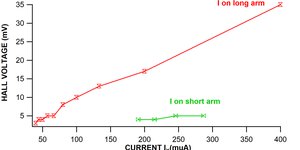The figure on the left shows the calculated spin-split Fermi surfaces of our MBE grown sample The spin-orbit splitting is assigned to the Dresselhaus effect, resulting from the lack of spatial inversion symmetry in the structure materials. The Dresselhaus parameter A43 is obtained from k.p theory for the electron system host material. However the full Shrödinger-Pauli Hamiltonian with the spin-orbit coupling term exhibit time reversal symmetry. Therefore this energy contour must exhibit Kramers degeneracy i.e. E(k, up)=E(-k, down). Because the band are significantly split, this imply the occurrence of 2 Discontinuity Points for a given spin orientation, indicated by DP labels and black arrows on Fig.1. We believe that these points occur along the direction of applied current.







